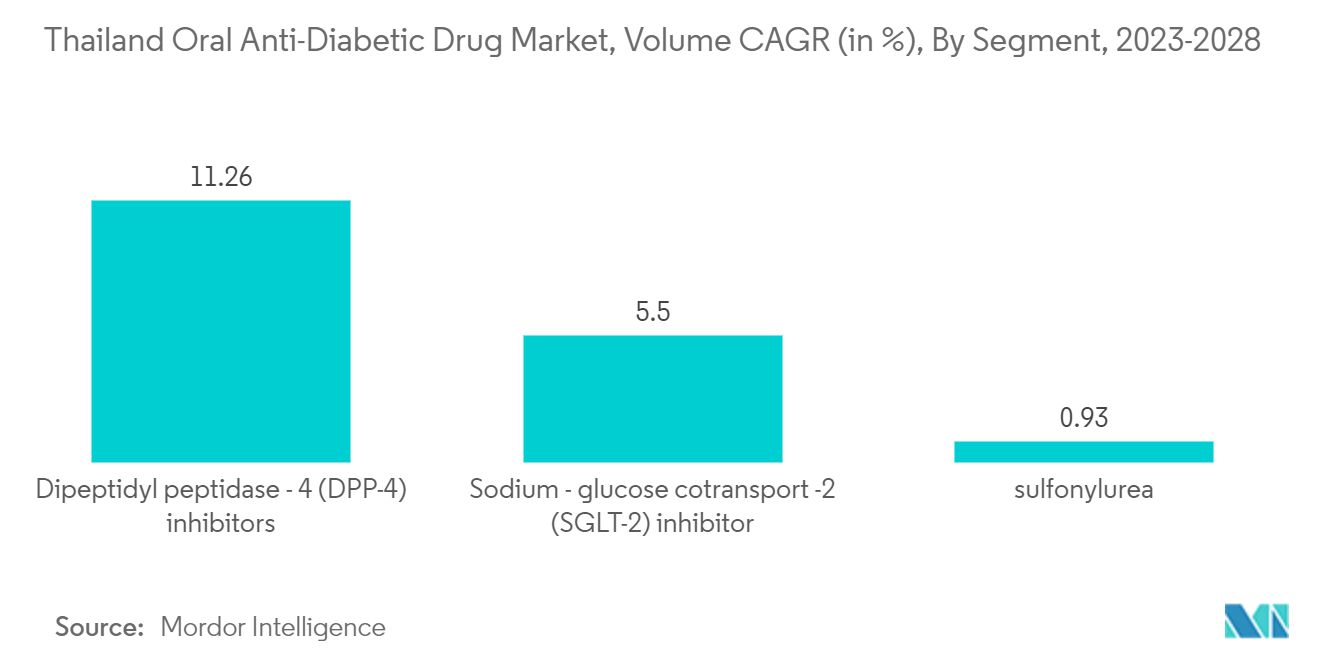Market Trends of Thailand Oral Antidiabetic Drug Industry
Sulfonylureas Segment Occupied the Highest Market Share in the Thailand Oral Anti-Diabetic Drugs Market in the current year.
Regarding revenue, the Sulfonylureas segment is anticipated to lead the Thailand Oral Anti-Diabetic Drugs Market and post a CAGR of over 1% during the forecast year.
Controlling blood pressure is an essential part of managing diabetes. Furthermore, to prevent renal and heart-related issues in patients with diabetes, even in the absence of high blood pressure, certain blood pressure-lowering drugs are commonly advised. Currently, no solid scientific proof connects these blood pressure medications to the chance of COVID-19 infection or its repercussions. To decrease the likelihood of long-term problems, increase QALY, and prolong life in type 2 diabetes patients who had previously had unsuccessful results with a sulfonylurea or metformin therapy. Although the greater cost in the pioglitazone group is mostly attributable to the drug cost, the therapeutic advantages of pioglitazone over rosiglitazone are primarily attributable to the superior lipid profile and glycemic control.
The most effective hypoglycaemic drug for treating diabetes is insulin therapy; however, if insulin is kept improperly, its effectiveness will degrade. Diabetes and other NCDs account for over 70% of all fatalities in Thailand. Being overweight raises the risk of type 2 diabetes by three times, while being obese increases the risk by nearly seven times.
Because of the country's robust primary healthcare system and universal health coverage, T2DM medical treatment is readily accessible. Less than half of diabetes patients in Thailand, according to surveys, have adequate management of clinical risk factors for the condition. Of these patients, 33% have ideal HbA1C levels, 44% have suitable LDL cholesterol levels, and 52% have adequate blood pressure control. Less than 60% of diabetic patients in Thailand receive thorough yearly screening; regular follow-up and screening for microvascular problems are also uncommon. The proper self-management of the condition is also necessary for T2DM control and preventing its consequences, in addition to access to and use of facility-based treatments. Evidence from Thailand suggests that having a multidisciplinary team to deliver holistic care for patients with diabetes may have advantages beyond just maintaining medication compliance.

The increasing diabetes population in Thailand is driving the market.
With a frequency of 9.9% in the adult population, Thailand has the seventh-largest number of diabetes patients in the Western Pacific. In Thailand, diabetes is one of the main causes of mortality. About 30,000 (or 15%) of Thailand's yearly fatalities from chronic non-communicable illnesses are brought on by diabetes. High blood sugar levels (hyperglycemia) are a symptom of diabetes mellitus, which a shortage of insulin hormones can bring on, a problem with insulin production, or both. Long-term high blood sugar levels can cause essential organs to malfunction, deteriorate, and be destroyed. Both changeable and immutable variables can contribute to an inability to manage blood sugar levels. Gender, age, the length of diabetes, microvascular and macrovascular complications, and comorbidities are non-modifiable variables. Behavioral and/or psychosocial problems, such as poor eating habits, inactivity, obesity, and failure to take prescribed medications as directed by a doctor, as well as stress, depression, and anxiety, particularly anxiety related to diabetes, are examples of modifiable factors.
The majority of doctors are aware that emotional distress is prevalent in their diabetic patients and that it negatively affects diabetes outcomes; nevertheless, many clinicians don't feel equipped to handle this distress. However, emotional issues have a negative impact on one's health in the form of poor self-care habits, poor metabolic results, morbidity, mortality, functional limits, and a decreased quality of life. These harmful outcomes are not just restricted to psychiatric diseases that can be diagnosed. Therefore, even if diabetic self-care is sufficient, treating these emotional issues is essential for a successful healthcare intervention. Diabetes-related Distress (DRD) screening is a crucial initial step in the treatment of mental health issues in T2DM patients as a result. Few investigations on the prevalence of DRD and its risk factors have been conducted in Thailand. Few research on the incidence of DRD and variables linked to DRD in T2DM have been conducted in Thailand. This study examined the prevalence and risk factors for DRD in people with type 2 diabetes.


